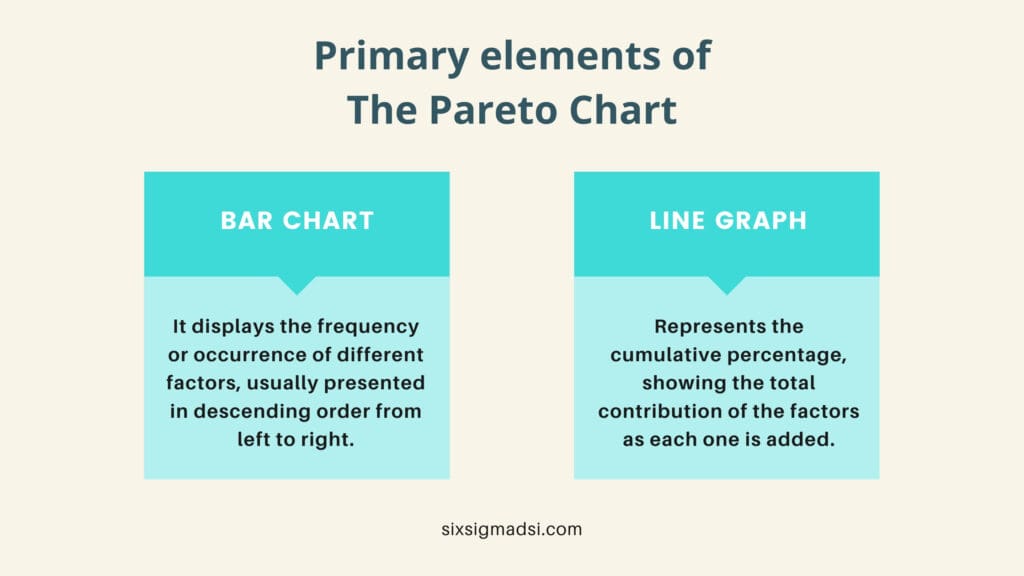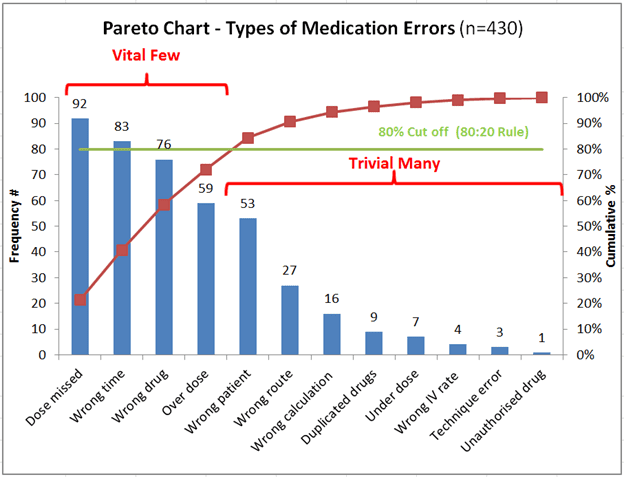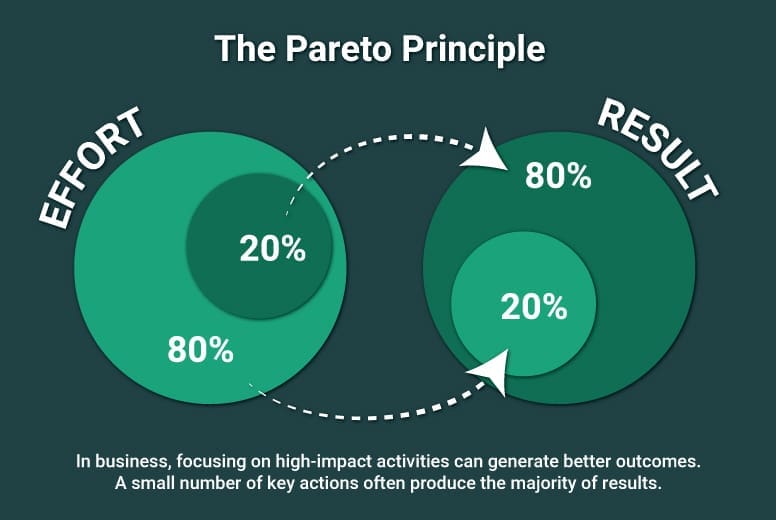Table of contents
- What is the Pareto Chart in Six Sigma?
- Primary Elements of The Pareto Chart
- What is the Pareto Principle (or 80/20 Principle)?
- Origin of the Pareto principle (or 80/20 principle)
- The Pareto principle (or 80/20 principle) and Lean Six Sigma
- Where to use the 80/20 Rule (or 80/20 principle)?
- Advantages of the Pareto chart
- Disadvantages of the Pareto chart
- The Pareto principle (or 80/20 principle) and the importance of scope
- Related Articles
Estimated reading time: 8 minutes
What is the Pareto Chart in Six Sigma?
A Pareto Chart or diagram is a graphical tool used in Six Sigma methodology to prioritize and focus on the most significant factors contributing to a problem. Pareto chart combines both bar and line graphs through diagrams to visually do analysis and highlight the most critical issues within a process.
Primary Elements of The Pareto Chart

- Bar Chart: The bar graph displays the frequency or occurrence of different factors, usually presented in descending order from left to right. This helps identify the most significant contributors to the problem.
- Line Graph (Cumulative Percentage Line): The line graph represents the cumulative percentage, also known as the Pareto diagram, and shows the total contribution of the factors as each one is added. This line assists in understanding the cumulative impact of the factors on the overall problem.
By using the Pareto Chart, Six Sigma practitioners can visually analyze data and identify the vital few factors that contribute the most to a particular issue. It assists in focusing efforts and resources on addressing these critical factors, leading to more effective problem-solving and process improvement initiatives.
What is the Pareto Principle (or 80/20 Principle)?
The Pareto Principle (or 80/20 principle) is an analysis system that states that 80 percent of events are caused by 20 percent of their causes. This means that a small number of causes can have a significant impact. This concept is crucial to grasp because it will help prioritize the initiatives with the greatest impact.
Examples of the Pareto principle in general:
- 20% of a company’s products yield 80% of its revenue.
- 20% of customers account for 80% of a company’s profits.
- 20% of defects in a process result in 80% of rework.
Origin of the Pareto principle (or 80/20 principle)
Vilfredo Pareto, an Italian economist, developed the Pareto principle in 1896. Pareto noticed that only 20% of Italy’s land was owned by the poor. Pareto also observed this in his garden: 20% of his plants were producing 80% of the fruit. This relationship can be mathematically described as a power-law distribution between two quantities. A change in one quantity causes a relevant change in the other.
The 80/20 rule does not represent a mathematical formula but is more of a generalized phenomenon that can also be applied to business, economics, and time management. This result is shown in a Pareto diagram to do an analysis.
The Pareto principle (or 80/20 principle) and Lean Six Sigma

It all started with Joseph Juran, who introduced quality control in the 1950s. Juran used the 80-20 Principle to identify the most serious and frequent causes of inferior quality. His clients, who were mostly Japanese, advised him to fix them first. They did. They rose from a devastated nation with no exports to become a stronghold in the 1980s.
Progress is about energy. Tiny amounts of energy can go a long way. The Pareto Principle tells us where the most bang for our buck is.
The 80/20 Principle is a scientific law that has been proven to be effective in both business and economics. It states that most results are due to a few causes or efforts. This is how it fits within the Lean Six Sigma framework. The 80-20 Principle is not a law, but an observation. Although not always true, the 80-20 and 99-1 distributions are often the most profitable. This is where you can make a lot of money with little effort.
Where to use the 80/20 Rule (or 80/20 principle)?
The 80/20 rule applies to every industry. However, the Pareto principle can be used in economics and business. The 80/20 rule helps you to determine where your efforts can be directed to maximize your output.
These are just a few examples of where you can use the tool:
Productivity: The 80/20 rule can be used to prioritize tasks you need to complete during the day. It is believed that 20% of your tasks will have the greatest impact on your day. To maximize your impact, focus on the tasks that have the greatest impact on your team. This is done by listing all the tasks that must be completed that day. Next, identify the most important tasks. Are there any tasks that require you to collaborate with others? Do you have any projects that are stalled because of the tasks you have? Although these tasks are simple to complete, they can have a significant impact on the flow of the project.
Making decisions: The Pareto principle is a way to help you make the right decisions in the problem-solving process. The Pareto principle is useful for analysis when there are multiple causes for a problem. It can help you prioritize the solutions. These are some steps that will help you understand how it works.
- Identify the root causes of your problems, use a tool such as the 5 Whys process to find the cause of all the problems you are trying to solve. Your problems can be grouped into related categories. You can group the causes of your problems if they fall under the same categories. This will help you determine if one solution is sufficient to solve multiple problems.
- Give each problem a value based on its impact on the business. You can use a number between 1 and 10 or a monetary value to indicate their importance.
- Create a plan that focuses on the top 20% of problems that have the greatest impact on your business. One solution can solve multiple problems. Calculate which problems are in the top 20 percent based on the assigned values to each problem. After identifying the problem, create a plan that will solve it using problem-solving strategies.
Advantages of the Pareto chart

- Prioritization: It helps in identifying and prioritizing the most significant factors or issues causing problems within a process.
- Visual Representation: The Pareto chart provides a clear analysis and visual representation of data, making it easy to comprehend and communicate to stakeholders.
- Focus on Critical Factors: Allows teams to concentrate efforts and resources on addressing the most impactful issues, leading to efficient problem-solving.
- Simple and Easy to Create: The chart is relatively simple to construct using basic tools like Excel or statistical software, making it accessible to many users.
- Data-driven Decision Making: Encourages data-driven decision-making by emphasizing the factors that contribute most significantly to a problem.
Disadvantages of the Pareto chart
- Limited Scope: The Pareto principle assumes an 80/20 distribution, but it might not always accurately reflect the situation. Sometimes, the distribution might differ significantly from 80/20, affecting the prioritization of issues.
- Overlooking Context: The chart doesn’t provide context or detail about the factors listed. It may lead to overlooking underlying complexities or interdependencies between factors.
- Subjectivity in Data Selection: Subjectivity might come into play when selecting and categorizing the factors, potentially leading to bias in the analysis.
- Ignores Cumulative Impact: While it highlights individual factors’ importance, it might neglect the cumulative impact of addressing multiple smaller factors, which could be equally significant.
- Static Representation: It offers a snapshot of the data at a specific point in time, potentially overlooking changes or shifts in factors’ significance over time.
Despite these limitations, Pareto Charts or diagrams remain valuable tools in the Six Sigma toolkit for their ability to provide a quick overview of the most critical issues and facilitate focused problem-solving efforts. Combining them with other analysis methods helps gain a more comprehensive understanding of the underlying issues within a process.
The Pareto principle (or 80/20 principle) and the importance of scope
You can’t solve world hunger, but you have a greater likelihood of success if you focus on one small village. This is where the Pareto principle of 80/20 comes into play, if you focus on the 20% of your processes that are causing 80% of your problems, you will have a manageable scope for your project, and if successful, will yield the most meaningful results.
Once you Improve, Optimize, and Control hunger in that small village then you can translate the improvements to the next village in our priority with subsequent “multi-generational projects”.
With each generation of projects to solve world hunger, each village gets easier. We can even expand our scope to improving several villages at once as we have encountered most of the variables in previous projects.

About Six Sigma Development Solutions, Inc.
Six Sigma Development Solutions, Inc. offers onsite, public, and virtual Lean Six Sigma certification training. We are an Accredited Training Organization by the IASSC (International Association of Six Sigma Certification). We offer Lean Six Sigma Green Belt, Black Belt, and Yellow Belt, as well as LEAN certifications.
Book a Call and Let us know how we can help meet your training needs.



















